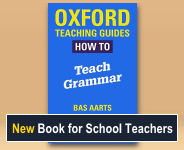Certainty and uncertainty
Sometimes we make confident statements, while at other times we want to express some uncertainty. In this resource we will explore the expression of certainty and uncertainty. This is one of the areas of meaning we call modality.
Goals
- Define modality.
- Explore means of expressing certainty and uncertainty.
- Apply our knowledge of modality to construct sentences with greater or lesser uncertainty.
- Rank example sentences in order of certainty.
- Compose short paragraphs using multiple tools for expressing certainty and uncertainty.
Lesson Plan
The teacher explains that today, we will discuss modality. One element of modality is the expression of certainty and uncertainty. How do we express certainty and uncertainty? There are many ways.
The Activity pages appear in the menu entitled 'This Unit' in the upper right.
Activity 1 contains four example sentences. Ask the students to re-write each sentence in a few different ways so that it appears less certain. Have them imagine that they want to express the ideas in each sentence, but that they aren't very sure that they're correct. What ways do they find to express uncertainty? They should have found a range of different ways, such as:
- Amy may/might have gone home. (modal verbs)
- I will possibly/probably have the essay written by tomorrow. (adverbs with modal meaning)
- I think/It is thought that this disease is caused by a virus. (expressions of thought)
- It is likely/possible that the British team will win this match easily. (adjectives with modal meaning)
These are not the only possibilities. What others did they find?
In Activity 2, students are asked to compare examples and decide which ones express the most uncertainty and which the least. They will be given sets of three examples on each slide. For each set they should do as follows:
- Rank the examples in order from most certain to most uncertain, with most certain at the top and most uncertain at the bottom. This may not be easy, and some examples may be debatable!
- Compare their rankings with those of other students. Are there any areas of disagreement?
- Identify any expressions in the examples that help to convey certainty or uncertainty.
Further work
As a follow-up project, ask students to compose two short pieces of writing (a paragraph each). They should choose two different things to write about:
- one that they feel very confident about – something from your own direct experience, or a topic they know well
- one that they don’t feel sure about – a topic of which they have limited knowledge, or perhaps an area of prediction about the future
They should try to reflect their level of certainty or uncertainty in the way they write, so that it will come across clearly to the reader.
Next, the students swap pieces of writing with other students. They then read each other’s work and discuss how the level of certainty comes across. They then see whether any changes are needed to express this better.
Finally, have a class discussion about these issues:
- What kinds of topics do we feel we have the authority to express certainty about?
- Can we think of examples of people who present themselves as authorities or experts in particular areas? How does this show in the way they express themselves?
- Are there particular contexts in which we want to express ourselves with more certainty, or less certainty?
- Do we sometimes express more or less certainty than we actually feel? Why?
Welcome!

Englicious is totally free for everyone to use!
But in exchange, we ask that you register for an account on our site.
If you’ve already registered, you can log in straight away.
Since this is your first visit today, you can see this page by clicking the button below.
- Printer-friendly version
- Log in to view or leave comments

